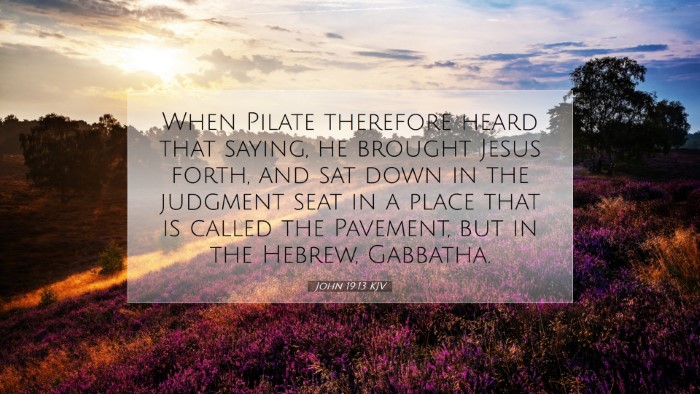Bible Commentary on John 19:13
John 19:13 reads: "When Pilate therefore heard that saying, he brought Jesus forth, and sat down in the judgment seat in a place that is called the Pavement, but in the Hebrew, Gabbatha." This verse encapsulates key elements of the Passion narrative, notably the judicial proceedings leading to Christ’s crucifixion. This commentary synthesizes insights from notable public domain theologians including Matthew Henry, Albert Barnes, and Adam Clarke.
Contextual Overview
To understand the weight of John 19:13, it is essential to consider the broader context of the trial of Jesus. Pilate, the Roman governor, finds himself in a politically charged situation, negotiating the conflicting interests of the Jewish leaders and the populace. The “judgment seat” (or bema) plays a crucial role here, serving as the location from which Pilate would make his fateful decision regarding Jesus.
Pilate's Position and Dilemma
Pilate's actions reveal his internal struggle. He is caught between his judicial duties and the pressure exerted by the Jewish authorities, who seek to eliminate Jesus. According to Matthew Henry, Pilate is depicted as a man more concerned with his political survival than with justice. His passive vacillation ultimately leads him to satisfy the crowd’s demands, reflecting the moral complexities of power.
Insights from Matthew Henry
- Pilate's Judgment Seat: Henry notes that the location being called "the Pavement" is significant, as it symbolizes the shifting sands of justice in this scenario. Pilate is presented as one who, despite having the authority to judge, is rendered ineffective by his fear of the crowd and loss of control.
- The Significance of Gabbatha: The Hebrew name "Gabbatha" denotes 'elevation,' suggesting a higher moral ground that Pilate fails to ascend. In failing to uphold justice, he illustrates the consequences of moral compromise.
Insights from Albert Barnes
- The Pavement's Physical Characteristics: Barnes emphasizes the literal aspect of the "Pavement," noting it was likely a mosaic, which could symbolize the mingling of different peoples (Jewish and Gentile) in the trial.
- Pilate’s Authority Interpreted: Barnes adds a layer of interpretation concerning Pilate's authority, pointing out that although he holds the judicial role, he is ultimately overruled by popular sentiment—a theme that resonates with the struggle of earthly kings grappling with divine sovereignty.
Insights from Adam Clarke
- Pilate's Reluctance: Clarke notes Pilate's evident reluctance and internal conflict. He sees that Jesus is innocent yet is manipulated into condemning Him by the very leaders who should have recognized Him as the Messiah.
- The Decision Made at Gabbatha: Clarke further elaborates on Gabbatha as a 'high place,' which metaphorically represents a crossroads—an opportunity for Pilate to choose righteousness but instead, he selects the path of political expediency.
Theological Implications
This passage carries profound theological implications, particularly regarding authority and responsibility. Pilate's role raises questions about the nature of power and its ethical exercise. His judgment reflects humanity's propensity to favor self-preservation over moral integrity. The decision made at this juncture leads to significant consequences—not only for Jesus but for all of humanity, as it is a pivotal moment in the redemptive narrative.
Application for Pastors and Theologians
For pastors and theologians, John 19:13 serves as a reminder of the pressing moral challenges faced in leadership. It beckons leaders to ground their decisions in biblical truth rather than succumbing to external pressures. The commentary highlights the need for discernment in the face of public opinion and the importance of standing firm in one's convictions.
Reflection for Students of the Bible
Students studying this text are encouraged to reflect on Pilate's judgment and the surrounding circumstances. It invites an examination of personal and societal complicity in injustice and the call to uphold righteousness, even amid adversity. Engaging with the insights of Henry, Barnes, and Clarke enriches the understanding of this critical moment in redemptive history.
Conclusion
In conclusion, John 19:13 encapsulates a moment of grave importance in the Gospel narrative. The insights gleaned from historical commentators provide layers of understanding that are significant for modern readers. This verse not only captures the essence of the trial of Jesus but also serves as a timeless challenge regarding justice, authority, and the profound consequences of our choices.


